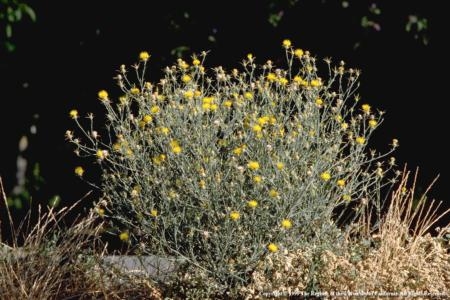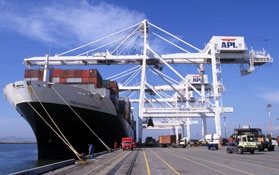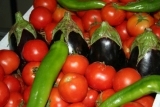Posts Tagged: free
Collaboration may be an effective way to fund wildland weed control
Many funding sources for weed eradication have been reduced or completely eliminated. According to the California Assembly Budget Committee’s annual Preliminary Review of the Governor’s Proposed 2012-13 State Budget, the California Department of Food and Agriculture will absorb a permanent budget reduction of $12 million in program cuts, in addition to a $19 million budget reduction in 2011-12. Funding for weed management areas (WMAs) has been reduced to the point that many WMAs have become inactive or are being managed voluntarily as an adjunct to other duties.
At the California Invasive Plant Council (Cal-IPC: http://www.cal-ipc.org/) annual symposium at Lake Tahoe in October, it was stressed that competition for limited funding will pit us against ourselves and each other. Only by working together, creating collaborative projects, will we be able to benefit from the limited funding opportunities available.
Enter the collaborative grant-funded project. Agencies are looking for applications that demonstrate community support from a diverse range of stakeholders. For example, the Sierra Nevada Conservancy (SNC) is currently reviewing proposals received in response to their Healthy Forests initiative. Proposition 84 — The Safe Drinking Water, Water Quality and Supply, Flood Control, River and Coastal Protection Bond Act of 2006 — will fund approved projects. Five million dollars is available this year for healthy forest projects; next year an equal amount will be available for rangeland projects.
Two weed control projects created by UC Cooperative Extension Central Sierra received SNC invitations to submit complete grant applications. One project is a collaboration between UCCE, the U.S. Forest Service, and Yosemite National Park; another works in partnership with Cal-IPC.
As an example of the collaborative partnerships being sought by funding agencies, the National Fish and Wildlife Foundation is offering the ‘Pulling Together Initiative’ which “seeks proposals that will help control invasive plant species, mostly through the work of public/private partnerships such as Cooperative Weed Management Areas.” Successful projects must “have a project Steering Committee composed of local cooperators who are committed to working together to manage invasive and noxious plants across their jurisdictional boundaries.”
Clearly, in light of decreased federal and state funding, a strategic direction for weed-control projects will be to leverage resources, working together to do what no one agency can accomplish alone.
Two additional collaborative projects, created by Wendy West of UCCE Central Sierra, are highlighted here:
- A Weed-Free Forage List providing California resources for weed-free feed and erosion control materials will soon be posted on Cal-IPC’s website. The site will also contain explanatory information about weed-free certification, along with links to inspection procedures and noxious weed lists.
- Workshops designed to help prevent the spread of weeds during construction, aggregate production and maintenance activities are being offered throughout the state. The workshop is hosted and sponsored by U.S. Forest Service, National Park Service, California Department of Food and Agriculture, University of California and University of Nevada Cooperative Extension, and the California Invasive Plant Council.
A Fresno County workshop was held in January and a sold-out workshop is scheduled for March in Los Angeles County. If you are located in the central California region that includes Amador, Calaveras, El Dorado, Madera, Mariposa, San Joaquin, Stanislaus or Tuolumne counties, please consider attending the next workshop, scheduled for April 9 in Sonora. The final workshop will be held in Truckee on May 2. Register for the workshops here.
Prevention Workshop 2012 flier
Workshop Schedule.Agenda
UC economists project farm export gains from free trade agreements
Analysis of the recently approved United States free trade agreement with South Korea in the April-June 2011 issue of the California Agriculture journal shows how California farm exports will now have much improved access to the large South Korean market, significantly enhancing competitive prospects for almonds, walnuts, dairy products, beef and oranges, among other important California commodities.
Legislation implementing the Korea free trade agreement, along with smaller agreements with Colombia and Panama, were negotiated several years ago. They finally gained Congressional approval on Oct. 12 and are set to be signed by President Obama on Oct. 21.
By phasing out or eliminating tariffs and other trade barriers, free trade agreements create larger markets for California-produced farm commodities. Since South Korea has no significant prospects to export farm goods to the United States, California agriculture is a clear winner from this agreement.
Hyunok Lee and Daniel Sumner from the Department of Agricultural and Resource Economics at UC Davis and the UC Agricultural Issues Center document the current importance of South Korea to California farm exports, the size of the trade barriers these exports have faced (many facing tariffs of more than 30 percent) and the advantages currently afforded by South Korea’s existing free trade agreements with important competitors, such as Chile and Australia.
“Lower trade barriers will allow California agriculture to better compete in a large, growing and lucrative market,” said Sumner.
“Food product prices are high in South Korea and consumers are willing to pay premiums for the high-quality products produced in California,” added Lee.
South Korea has a strong economy with about 50 million consumers and per-capita income of $30,000, higher than many European countries. In 2010, the value of California farm exports to South Korea was more than $400 million. Given the size of South Korea’s economy and the high trade barriers being erased, Sumner and Lee say the accord will do more for farm exports than agreements negotiated for almost 20 years.
Among other findings, the authors report that:
- The top California ag exports to South Korea are fresh oranges, with tree nuts, rice, and beef and beef products also in the top five.
- Other California crops that hold a double-digit share of the South Korean market are hay, grape juice and kiwifruit.
- With an import tariff of about 45 percent, South Korean imports of California table grapes, fresh strawberries, fresh apples and lettuce and rice are small, but have great potential for growth.
- South Korea is becoming a major export market for California grapefruit and lemons. Lower tariffs will increase demand.
- The United States is South Korea’s only supplier for almonds and the U.S. has more than a 90 percent share of walnuts. The current 8 percent almond tariff will be eliminated and walnut tariffs will be phased out over the next 6 to 15 years.
- Beef products are the top agricultural import (from all sources) into South Korea by value. With the new agreement, the within-quota tariff will fall by 2.7 percent each year, providing a gain for U.S. producers compared to import competitors.
- South Korea has high trade barriers for many dairy products, but with gradual reductions under the new agreement, the market will grow.
MEDIA CONTACTS:
Daniel Sumner is available to comment on the free trade agreements with South Korea, Panama and Columbia. He can be reached at dasumner@ucdavis.edu, (530) 752-1668.
Hyunok Lee can comment about the size and potential growth of the Korean market. She can be reached at (530) 752-3508, hyunok@primal.ucdavis.edu.
Free information on food: Nutrition, food handling, safety, cooking, etc.
Mention that something is free and useful, and most of us will stop to take a look. And for good reason — the University of California has a number of websites that offer free information related to food.
Take your time to peruse the sites listed below. There is some fascinating and very handy information to be had. Many of these sites also offer terrific publications at nominal prices, but this blog lists only those that are free . . . and we all love a bargain! Many more publications and programs are available than those listed below.
After looking at these lists, you never know when you’ll be inspired to pickle some olives or field dress a deer. As for me, my latest food craze is cheese-making. Two weeks ago I made goat cheese (chèvre, to be sure), and last weekend I made camembert and blue cheeses. Now I just have to be patient for two months while they ripen . . .
Bon appétit and healthful eating!
UC Agriculture and Natural Resources publications [link]
- Tomatoes: Safe methods to store, preserve, and enjoy [link]
- Olives: Safe methods for home pickling [link]
- Egg basics for the consumer: Packaging, storing, and nutritional information [link]
- Guidelines for food safety during short-term power outages: Consumer fact sheet [link]
- Key points of control and management for microbial food safety: Edible landscape [link]
- Safe handling of fruits and vegetables [link]
- Safe methods of canning vegetables [link]
- The healthy brown bag: 15 lunches for school-aged children [link]
Postharvest Technology Research and Information Center [link]
- Storing fresh fruits and vegetables at home – poster (first copy free) [link]
Fruit and Nut Research and Information Center [link]
- The Backyard Orchard – A plethora of publications on growing and harvesting in the home orchard [link]
Nutrition publications from UC Davis [link]
- Nutrition and health information sheets on everything from energy drinks to osteoporosis to anemia, and more [link]
- EatFit - An interactive web program to aid middle-school students in personal dietary analysis and "guided goal setting" [link]
- “Nutrition Perspectives” newsletter - Research-based information on ongoing nutrition and food-related programs [link]
- “Nutrition to Grow On” - A curriculum for grades four through six that offers teachers a direct link between the garden and nutrition education [link]
Food Safety Videos
- Take a look at these humorous — but serious — music videos on food safety by renowned food safety expert Dr. Carl Winter. Who knew that the Beatles’ classic “I Wanna Hold Your Hand” could morph into “You’d Better Wash Your Hands”? [link]
- More food safety music [link]
Cooperative Extension Offices [link]
- Many county offices have publications on food production that is specific to climatic or regional needs of that county.
Publication of the Day!
- Protecting food safety when shooting, field dressing, bringing a deer home, and cutting the carcass [link]
UC scientist differs with pop icon on climate change
"Meat free Monday, it's a fun day, and it's happenin', all around the world." - former Beatle Paul McCartney.
You have only to watch singer Paul McCartney's Meat Free Monday song on YouTube (see below) to be convinced of his commitment and sincerity when it comes to getting the world to adopt Meat Free Monday. McCartney believes cutting back on meat and dairy consumption would have a significant environmental impact. But a UC Davis researcher says science is raining on McCartney's parade.
Author of the Fresno Bee Earth Blog, Mark Grossi, picked up on a UC Davis news release distributed this week that says meat shouldn't be blamed for climate change.
Grossi wrote that McCartney believes meat-free Mondays would empower individuals to fight global warming, basing his assertion on a report from the United Nations Food and Agriculture Organization called "Livestock's Long Shadow."
UC Davis Cooperative Extension Specialist Frank Mitloeher did his own study, however, and came up with a different conclusion. He said only 3 percent of the global warming contribution comes from livestock. Cutting back the use of fossil fuels will have a much greater impact.
"Smarter animal farming, not less farming, will equal less heat," Mitloehner was quoted in the release. "Producing less meat and milk will only mean more hunger in poor countries."
Mitloeher also shared his feelings about Paul McCartney's advocacy for Meat Free Mondays on Capital Public Radio.“I value him very much as a musician," Mitloeher told reporter Steve Milne, "but not as a climatologist."



